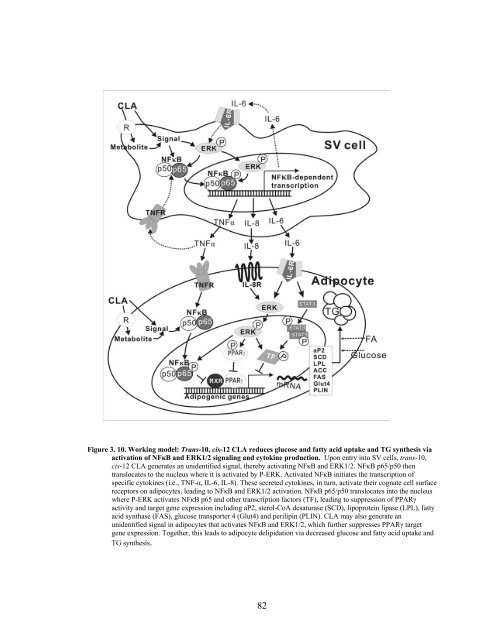CHUNG, SOONKYU, Ph. D. Mechanisms by Which Conjugated ...
CHUNG, SOONKYU, Ph. D. Mechanisms by Which Conjugated ...
CHUNG, SOONKYU, Ph. D. Mechanisms by Which Conjugated ...
Create successful ePaper yourself
Turn your PDF publications into a flip-book with our unique Google optimized e-Paper software.
Figure 3. 10. Working model: Trans-10, cis-12 CLA reduces glucose and fatty acid uptake and TG synthesis via<br />
activation of NFκB and ERK1/2 signaling and cytokine production. Upon entry into SV cells, trans-10,<br />
cis-12 CLA generates an unidentified signal, there<strong>by</strong> activating NFκB and ERK1/2. NFκB p65/p50 then<br />
translocates to the nucleus where it is activated <strong>by</strong> P-ERK. Activated NFκB initiates the transcription of<br />
specific cytokines (i.e., TNF-α, IL-6, IL-8). These secreted cytokines, in turn, activate their cognate cell surface<br />
receptors on adipocytes, leading to NFκB and ERK1/2 activation. NFκB p65/p50 translocates into the nucleus<br />
where P-ERK activates NFκB p65 and other transcription factors (TF), leading to suppression of PPARγ<br />
activity and target gene expression including aP2, sterol-CoA desaturase (SCD), lipoprotein lipase (LPL), fatty<br />
acid synthase (FAS), glucose transporter 4 (Glut4) and perilipin (PLIN). CLA may also generate an<br />
unidentified signal in adipocytes that activates NFκB and ERK1/2, which further suppresses PPARγ target<br />
gene expression. Together, this leads to adipocyte delipidation via decreased glucose and fatty acid uptake and<br />
TG synthesis.<br />
82

















